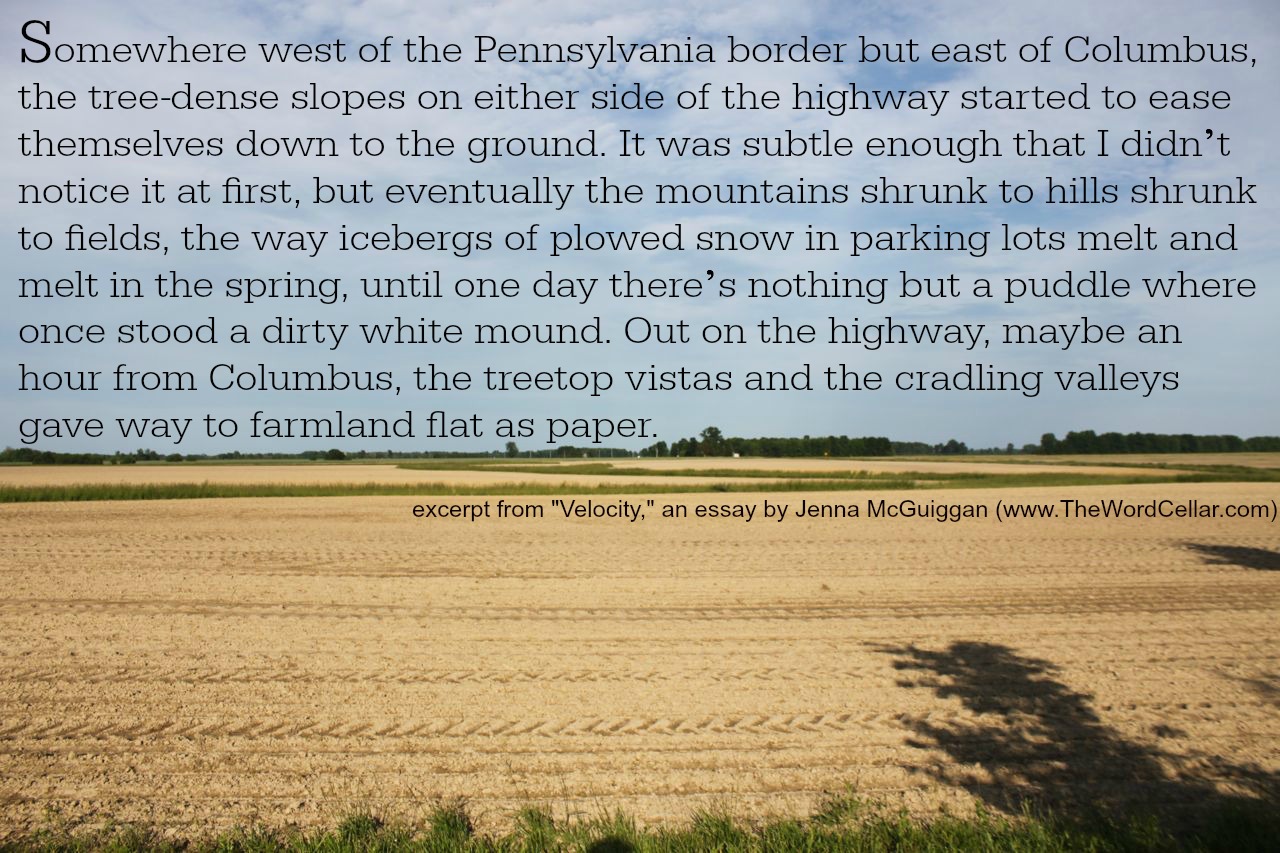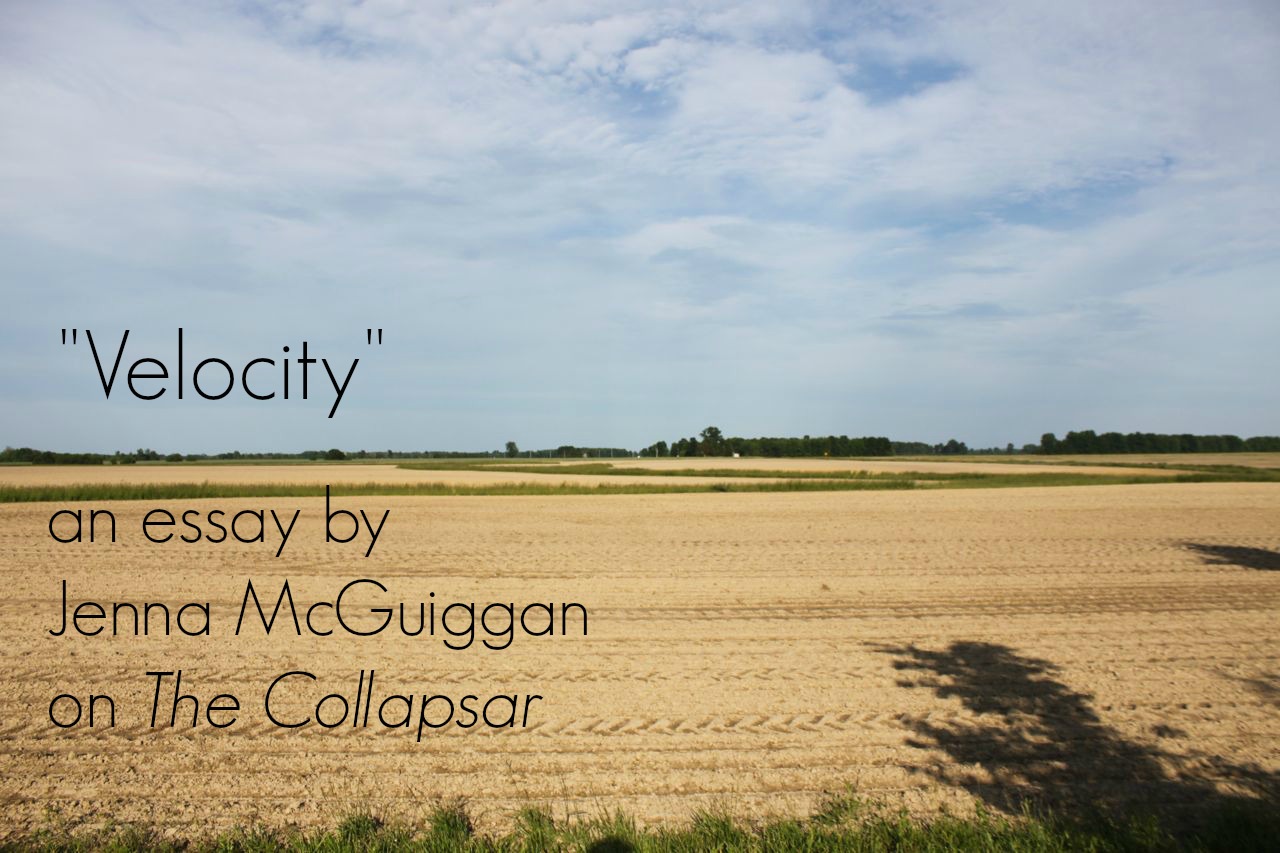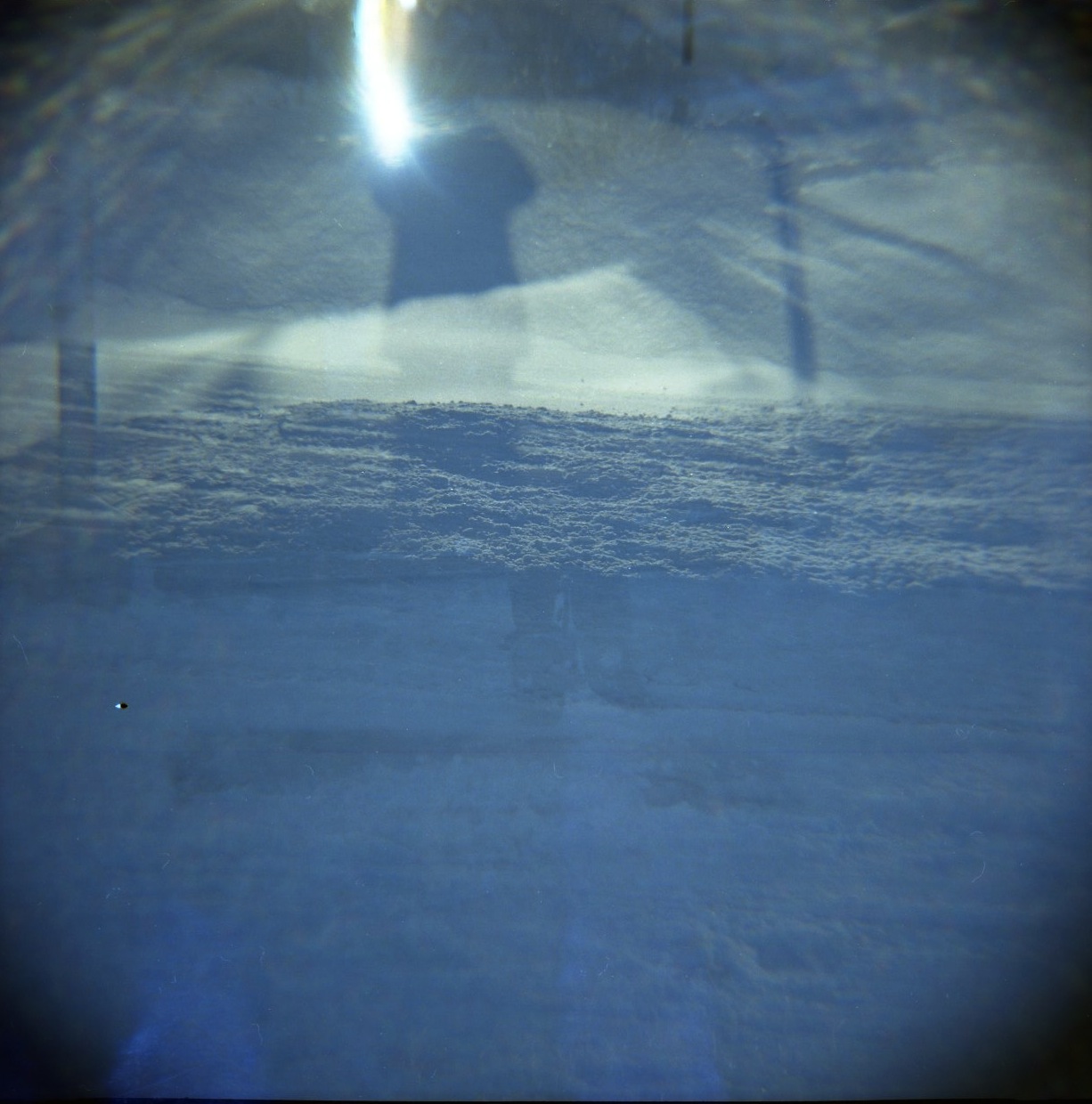Velocity
 Monday, July 7, 2014 at 6:38PM
Monday, July 7, 2014 at 6:38PM 
{A slightly different version of this essay was originally published in The Collapsar.}
Somewhere west of the Pennsylvania border but east of Columbus, the tree-dense slopes on either side of the highway started to ease themselves down to the ground. It was subtle enough that I didn’t notice it at first, but eventually the mountains shrunk to hills shrunk to fields, the way icebergs of plowed snow in parking lots melt and melt in the spring, until one day there’s nothing but a puddle where once stood a dirty white mound. Out on the highway, maybe an hour from Columbus, the treetop vistas and the cradling valleys gave way to farmland flat as paper.
Last spring I drove to and from Ohio twice in eleven days, and each time that I hit the edge of the heartland, an unexpected unease set in. The same thing happened a few years ago when I drove from my home in southwestern Pennsylvania to Indiana for the first time. Somewhere around Sandusky the landscape changed, and I understood why Ohio is part of the Midwest. In all three cases, when the foothills of the Appalachians melted away into plains carved by ancient glaciers, my internal compass went haywire. I felt twitchy. Overexposed. As though I were suspended in a perpetual state of waiting.
***
In a grocery store parking lot in Ashland, Ohio, I saw an Amish family: Mother in her bonnet. Father in his beard and suspenders. Young son in his little-man hat. They climbed into their black horse-drawn buggy and drove away. I was eating baby carrots and hummus inside my blue RAV-4, having a quick snack before I started the 190-mile trip home. With one or two rest stops along the way, I’d be back in my living room in three and a half hours. The same trip in an Amish carriage would take nearly 24 hours. That’s without stops and going full-tilt at a buggy’s top average speed of 8 miles an hour. If the horse is slow, you’re looking at a full day and a half on the road.
***
My second spring trip to Ohio took me six hours west and south to Cincinnati, and then two minutes over the river into Kentucky. At that point, things begin to tilt Southern and the terrain picks up some more hills.
Six hours west and north from my front door puts me near South Bend, Indiana, which is just a short commute to Michigan, a state I’ve never visited.
When I was a kid, six hours in the car invariably meant heading east to our family’s annual New Jersey beach vacation.
Six hours on a plane has taken me west to Seattle and east to London.
Six hours in a carriage with a fast horse would get me almost from my house to Pittsburgh International Airport 50 miles away.
***
The first telescope was unveiled in the Netherlands in the early 1600s. Scientists finally confirmed the existence of the first planet beyond our solar system in 1992. In the last 20 years, they’ve confirmed hundreds and hundreds more, with a projection that several hundred-billion others pepper the vast tracts of the universe. Hundreds of billions of planets, up from fewer than 10, in just two decades. These are true astronomical numbers, beyond human scale. A million, a billion, a trillion, a google. The words roll out of our mouths with all their implied zeros subsumed in a few syllables. No one can count that high.
***
Jetlag is more than the effects of crossing timezones. It’s an affliction deeper than knowing when to sleep and when to wake. Travel far enough or often enough by plane, and sooner or later you’ll need to sit yourself down and wait for your soul to catch up with your body. Your internal compass, the one that tells you where you are in the world, and why and how to be there, will need some time to reset.
***
How fast is too fast? How far is too far? Are human beings meant to travel at 300 miles an hour through the air? Are we meant to travel at 65 miles an hour in a car? Astronauts on the space shuttle Atlantis travel at a top speed of 17,500 miles in orbit, a sunrise and sunset to greet them every 45-minutes. The fastest marathon runners reach a speed of about 12 miles an hour, one and a half times faster than that Amish horse-and-buggy. Most of us walk at a pace of about 3 miles per hour. At that rate, it would take me more than two-and-a-half days of nonstop ambulation to reach Ashland, Ohio, from my house in western Pennsylvania. On October 14, 2011, a 23-year-old named Andrew Forsthoefel walked out of his front door in eastern Pennsylvania and set about walking 4,000 miles across the continent. He arrived at the Pacific Ocean 332 days later. That’s an average pace of 12 miles per day.
***
An old, lone tree stands in the middle of a field. You see it all the time in farmland if you look for it: a giant maple or oak keeping vigil on an island of grass, smack dab in the middle of tilled brown earth. A shady oasis for farmers, some say; a holdover from the old days before motorized equipment could take you quickly from one end of the wide field to the barn. Or shade for livestock, should the field be used for grazing. Or a landmark by which to keep track of your location in all those featureless acres, others say. Or the result of intact land where large boulders made clearing it impossible. Or an invitation of hospitality to birds that eat the fieldmice. Or, as the Irish say, a portal to the fairy world. Or a simple matter of aesthetics and sanity, something beautiful to rest the eyes from the terror of all that open space. A single tree in the perpetual act of waiting.
 essay,
essay,  everyday essays,
everyday essays,  one-moment memoir
one-moment memoir 


